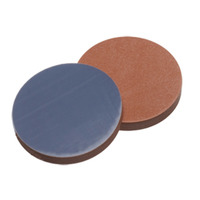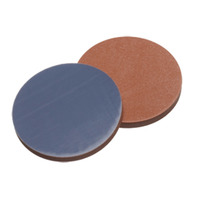Septa, 22 mm
The choice of the right septa depends on the application. Many septa are PTFE coated on one side. PTFE is highly resistant against many chemicals and forms an inert border between the sample and the base material of the septa.
The septa's base material has various physical and chemical properties, like temperature resistance, resealability, cleanliness, hardness and thickness.
Natural rubber/TEF
rature-resistant from -40 °C to 120 °C
RedRubber/PTFE
- Tempe
Butyl/PTFE
- Tempe
Silicone/PTFE
- Tempe
| Description | Hardness | Thickness | PK | Cat. No. | ||
|---|---|---|---|---|---|---|
| mm | ||||||
| Butyl red / PTFE grey | 55° shore A | 2.5 | 1000 | 6207230 | Open webshop | |
| Silicone white / PTFE beige, EPA quality | 45° shore A | 3.2 | 1000 | 7609927 | Open webshop | |
| Silicone white / PTFE blue, cross-slitted | 55° shore A | 1.5 | 1000 | 7636710 | Open webshop | |
| Silicone white / PTFE red | 45° shore A | 1.3 | 1000 | 7625234 | Open webshop |




